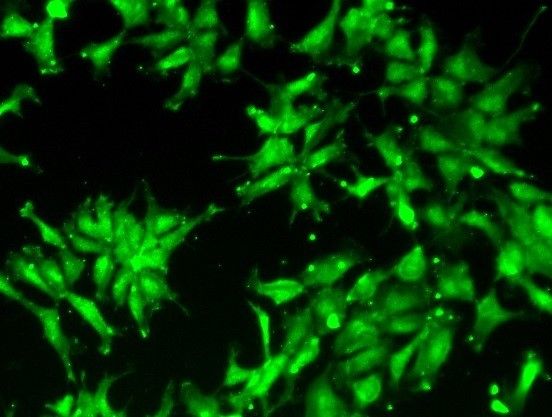Human beta-Catenin Antibody Summary
aa 2-781
Applications
Please Note: Optimal dilutions should be determined by each laboratory for each application. General Protocols are available in the Technical Information section on our website.
Scientific Data
 View Larger
View Larger
beta ‑Catenin in SW480 Human Cell Line. beta -Catenin was detected in immersion fixed SW480 human colorectal adenocarcinoma cell line using 10 µg/mL Mouse Anti-Human beta -Catenin Monoclonal Antibody (Catalog # MAB13291) for 3 hours at room temperature. Cells were stained with the NorthernLights™ 557-conjugated Anti-Mouse IgG Secondary Antibody (red; Catalog # NL007) and counter-stained with DAPI (blue). View our protocol for Fluorescent ICC Staining of Cells on Coverslips.
 View Larger
View Larger
beta ‑Catenin in Human Pancreas. beta -Catenin was detected in immersion fixed paraffin-embedded sections of human pancreas using Mouse Anti-Human beta -Catenin Monoclonal Antibody (Catalog # MAB13291) at 1.7 µg/mL overnight at 4 °C. Tissue was stained using the Anti-Mouse HRP-DAB Cell & Tissue Staining Kit (brown; Catalog # CTS002) and counterstained with hematoxylin (blue). Specific staining was localized to plasma membranes. View our protocol for Chromogenic IHC Staining of Paraffin-embedded Tissue Sections.
 View Larger
View Larger
Detection of Human beta-Catenin by Immunocytochemistry/Immunofluorescence Overview of Multi-dimensional Microscopic Molecular Profiling (MMMP).The overall MMMP approach is depicted using an example tissue section from normal human duodenum (sample #1.9.7). (a) Slides were subjected to repeated cycles of staining and imaging with fluorescent primary antibodies and DAPI. At the end of each cycle, fluorescent signal was removed by a chemical bleaching process, and slides were again imaged, before proceeding to the next round of this iterative procedure. After the final antibody stain (#15 Sma), slides were analyzed with a series of histochemical stains. (b) A set of tiling images spanning each tissue section was initially generated by the microscope system. The tiling images were then computationally ‘stitched’ together to produce a single image per staining cycle for each sample. (c) Image registration was performed to align images from the same tissue section across cycles. Mean intensities of the DAPI signal from all immuno-fluorescence images are shown from before (Unregistered) and after (Registered) the image registration procedure was completed. (d) Following registration, signal intensities from the relevant channels for each image (columns) in the MMMP series were extracted for each pixel (rows) within the tissue section and compiled into a large data matrix of in situ molecular profiles. Image collected and cropped by CiteAb from the following publication (https://dx.plos.org/10.1371/journal.pone.0128975), licensed under a CC-BY license. Not internally tested by R&D Systems.
Reconstitution Calculator
Preparation and Storage
- 12 months from date of receipt, -20 to -70 °C as supplied.
- 1 month, 2 to 8 °C under sterile conditions after reconstitution.
- 6 months, -20 to -70 °C under sterile conditions after reconstitution.
Background: beta-Catenin
Beta-Catenin is a cadherin-associated protein that is involved in the regulation of cell adhesion. It also acts as as transcriptional co-activator in the nucleus and is also involved the canonical Wnt signal transduction pathways.
Product Datasheets
Citations for Human beta-Catenin Antibody
R&D Systems personnel manually curate a database that contains references using R&D Systems products. The data collected includes not only links to publications in PubMed, but also provides information about sample types, species, and experimental conditions.
9
Citations: Showing 1 - 9
Filter your results:
Filter by:
-
HSV-1 single-cell analysis reveals the activation of anti-viral and developmental programs in distinct sub-populations
Authors: Nir Drayman, Parthiv Patel, Luke Vistain, Savaş Tay
eLife
-
A Potential Role of Semaphorin 3A during Orthodontic Tooth Movement
Authors: S ?en, CJ Lux, R Erber
International Journal of Molecular Sciences, 2021-08-02;22(15):.
Species: Human
Sample Types: Whole Cells
Applications: ICC -
The Glypican proteoglycans show intrinsic interactions with Wnt-3a in human prostate cancer cells that are not always associated with cascade activation
Authors: GFA de Moraes, E Listik, GZ Justo, CM Vicente, L Toma
BMC molecular and cell biology, 2021-05-04;22(1):26.
Species: Human
Sample Types: Cell Lysates, Whole Cells
Applications: Flow Cytometry, IHC, Immunoprecipitation, Western Blot -
HSV-1 single-cell analysis reveals the activation of anti-viral and developmental programs in distinct sub-populations
Authors: Nir Drayman, Parthiv Patel, Luke Vistain, Savaş Tay
eLife
Species: Human
Sample Types: Whole Cells
Applications: Immunocytochemistry -
Tissue expression of ?-catenin and E- and N-cadherins in chronic hepatitis C and hepatocellular carcinoma
Authors: A Kasprzak, K Rogacki, A Adamek, K Sterzy?ska, W Przybyszew, A Seraszek-J, C Helak-?apa, P Pyda
Arch Med Sci, 2017-01-19;13(6):1269-1280.
Species: Human
Sample Types: Whole Tissue
-
Automated Analysis and Classification of Histological Tissue Features by Multi-Dimensional Microscopic Molecular Profiling.
Authors: Riordan D, Varma S, West R, Brown P
PLoS ONE, 2015-07-15;10(7):e0128975.
Species: Human
Sample Types: Whole Tissue
Applications: IHC-P -
SULF2 overexpression positively regulates tumorigenicity of human prostate cancer cells.
Authors: Vicente C, Lima M, Nader H, Toma L
J Exp Clin Cancer Res, 2015-03-14;34(0):25.
Species: Human
Sample Types: Whole Cells
Applications: Flow Cytometry, IHC -
E-cadherin-expressing feeder cells promote neural lineage restriction of human embryonic stem cells.
Authors: Moore RN, Cherry JF, Mathur V
Stem Cells Dev., 2011-06-01;21(1):30-41.
Species: Human
Sample Types: Whole Cells
Applications: ICC -
Survivin in the human hair follicle.
Authors: Botchkareva NV, Kahn M, Ahluwalia G, Shander D
J. Invest. Dermatol., 2006-08-31;127(2):479-82.
Species: Human
Sample Types: Whole Tissue
Applications: IHC
FAQs
No product specific FAQs exist for this product, however you may
View all Antibody FAQsReviews for Human beta-Catenin Antibody
Average Rating: 4.8 (Based on 5 Reviews)
Have you used Human beta-Catenin Antibody?
Submit a review and receive an Amazon gift card.
$25/€18/£15/$25CAN/¥75 Yuan/¥2500 Yen for a review with an image
$10/€7/£6/$10 CAD/¥70 Yuan/¥1110 Yen for a review without an image
Filter by:
Specificity: SpecificSensitivity: SensitiveBuffer: 5% milk in TBSTDilution: 1/500
Specificity: SpecificSensitivity: SensitiveBuffer: 1% BSA + 0.3% Triton X-100 in PBSDilution: 1/100














